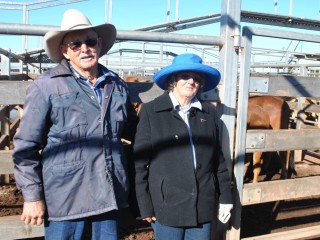 Cold, dry conditions and producer resistance to current price levels contributed to significant falls in cattle yardings across eastern Australia this week.
Cold, dry conditions and producer resistance to current price levels contributed to significant falls in cattle yardings across eastern Australia this week.
Selling agents report that dry conditions in particular are having a big impact on supply coming forward.
Numbers were back to 4850 head at Tuesday’s Roma store sale, closer to normal levels after last week’s sudden spike to 8200 head with the traditional run of several large lines of local vendor bred cattle for the first sale of the new financial year.
The volume injection of quality young steers and heifers last week attracted store buyers from as far south as Wangaratta in Victoria, with the additional competition increasing prices for medium yearling steers by 16c/kg and lightweight heifers by 12c/kg.
The trend was largely reversed this week however when the return to normal yardings was matched by a smaller contingent of restockers in the buying panel. Light yearling steers eased by 8c/kg to average 213c/kg and medium yearling steers eased 24c/kg to average 183c/kg.
A high point was the strong demand evident for heifers, with lightweight yearling heifers to feedlot buyers rising 8c/kg to average 193c/kg and to restocker buyers for an average of 201c/kg. Medium weight yearling heifers to feed rose 11c/kg to average 193c/kg.
Lack of supply this week also forced the direct cancellation of planned sales for Longreach and Blackall, and saw numbers at yesterday’s Roma prime sale drop back from previous weekly yardings of 2300-2500 head to 1700.
“The cattle just aren’t there to get at the moment,” Landmark Roma branch manager Rod Turner said.
“It is amazing after all the seasons we have had, in a lot of places cattle haven’t done as well as they thought they were going to do.
“They haven’t got the weight on, and plus we have had a pretty harrowing week of very cold wet weather here, and t has set cattle back, and the country has dried out again too.”
Adding to the seasonal restrictions on supply was a tendency by producers to hold cattle back at current price levels he said.
“They have got the grass this year and if they don’t like the market they can just sit on them.”
Further south at Dubbo numbers were also back from a spike last week, with agents yarding 3100 head yesterday, back from 3800 last Thursday.
Paul Jameson from Elders Dubbo said many selling centres across NSW were finding that the numbers of cattle weren’t there, as drier winter conditions affected feed quality and forage crop turnoff.
However while conditions were dry in the 200km drawing radius around Dubbo, yardings at the centre were still being boosted by large numbers of prime condition cattle feeding in from the far west, particularly Broken Hill, Tibooburra, White Cliffs and Walgett, after a good season in the region.
“It probably has dried off a little bit, but the cattle we have seen coming out of there are in very good condition, as good as we have seen,” Mr Jameson said. “There is plenty of weight.”
Some of the consignments received in recent weeks were indicative of the run of rough years the region had experienced prior to this year, he said.
“We have seen clients sell anything from big four and five year old bullocks right down to fresh six and eight month old vealer calves that have been prime.
“They have probably not had a muster for a year or two and with the good season they are having now they have got a few in and they have been in very good order, and while the market is reasonable they have sent them.”
He said some vendors with young cattle may be holding cattle back from the market in anticipation of possible rises ahead, given that historically the eastern cattle index tends to rise in August.
Mr Jameson said cows and domestic trade cattle were selling well.
“Even with the dollar as high as it is, the cow market and the export market is actually still quite strong.
“We’ve seen plenty of finished cows still making well into the $1.40s, close to $1.50 which relative to a lot of other descriptions I think is still quite strong.”
Strong southern demand for heavy cows was also evident in Victoria this week, with values for 196 score cows at Wodonga on Wednesday rising by 4c to average 153c/kg, and heavy cows from good to very good 3, 4 and 5 score condition making from 145c to 165c/kg at Pakenham the previous day.
Mr Jameson said cattle for domestic slaughter such as prime vealers and yearlings in the 300kg to 380kg-400kg category were selling very strongly.
“Seasonally there is not a lot of a lot them through the market, so when they do come in there is good demand for them,” Mr Jameson said.
Despite continued tough conditions for processors trying to sell Australian boxed beef into major markets such as Japan, and resulting contractions in processing shifts, the Eastern Young Cattle Indicator has held relatively stable in recent weeks, trading with a 5.75c/kg range within that time.
It closed at 375.75c/kg last night, 0.75c/kg higher for the week and 25.5c/kg or 7pc higher than this time last year.



HAVE YOUR SAY